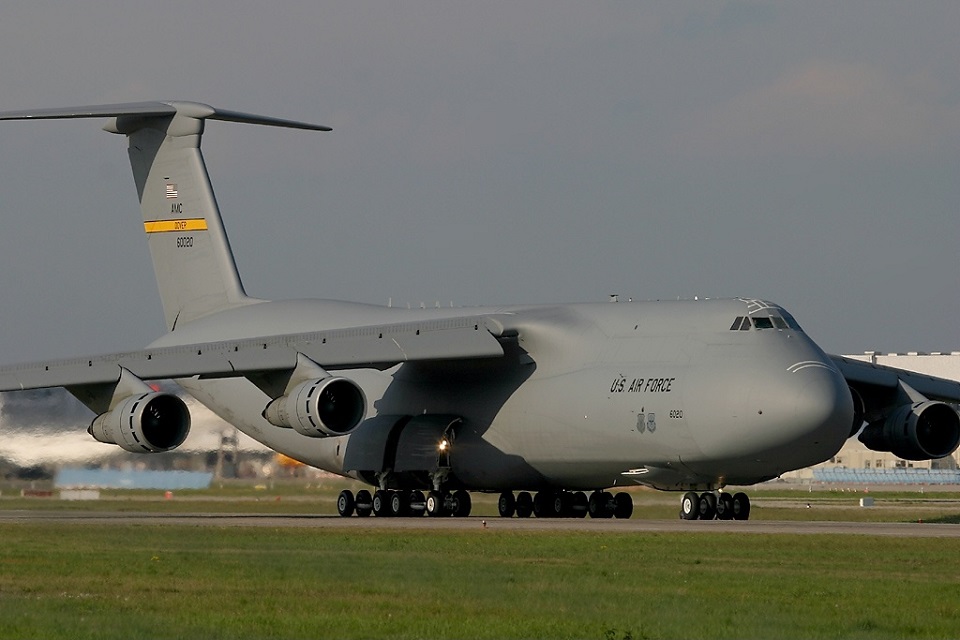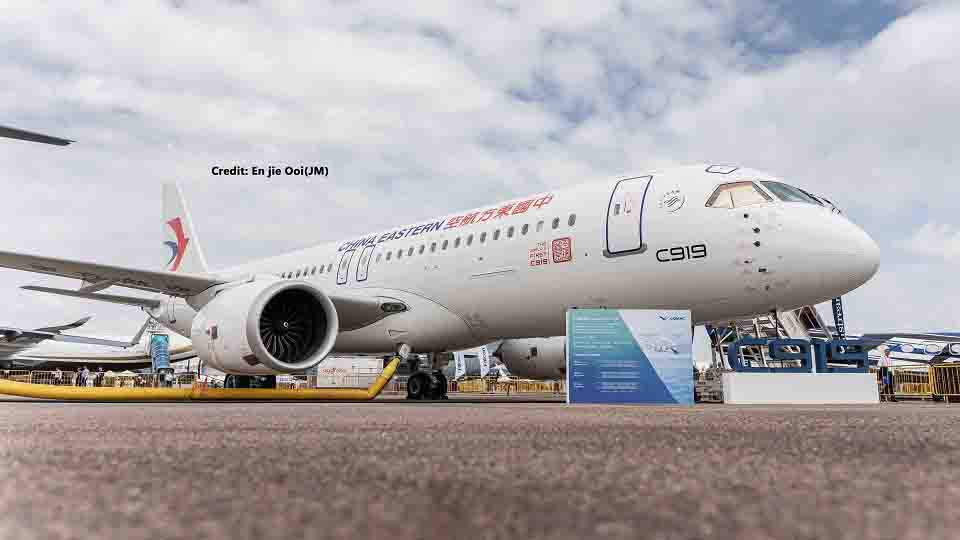Aviation
10 Fascinating facts about Lockheed C-5 Galaxy

The Lockheed C-5 Galaxy stands as an iconic symbol of strategic airlift capability, embodying sheer size, power, and versatility in military aviation.
Lockheed C-5 Galaxy, originally designed and constructed by Lockheed, is now maintained and upgraded by its successor, Lockheed Martin. Serving the United States Air Force (USAF), it delivers a robust heavy intercontinental-range strategic airlift capability. Notably, the C-5 can transport both outsized and oversized loads, encompassing all air-certifiable cargo requirements.
During a span of 21 years from 1968 to 1989, Lockheed, the manufacturer of the iconic C-5 Galaxy jets, rolled out a total of 131 of these colossal aircraft.This production span yielded two primary variants: 81 C-5A planes and 50 C-5B aircraft, showcasing remarkable engineering feats.
Over time, upgraded iterations further bolstered the C-5’s status as a cornerstone of military transport. Solely utilized by the United States Air Force since its inception, the C-5 continues to play a vital role in aerial logistics, executing missions with unparalleled capability. While production has ceased, the enduring legacy of the C-5 stands as a testament to aviation excellence.
As one of the largest aircraft ever built, the C-5 has played a pivotal role in global logistics, enabling the rapid transport of troops, equipment, and humanitarian aid across vast distances. Here are ten key aspects that define the remarkable Lockheed C-5 Galaxy aircraft.
Payload Capacity: The C-5 Galaxy boasts an astonishing payload capacity, capable of carrying up to 135 tons of cargo, providing heavy intercontinental-range strategic airlift capabilities for transporting large amounts of material around the world.
High-Wing Design: Sporting a distinctive high-wing design, the C-5 Galaxy provides ample clearance for loading and unloading cargo, as well as facilitating aerial refueling operations.
T-Tail Configuration: The aircraft’s T-tail configuration, featuring a vertical stabilizer, enhances stability and control, crucial for maneuvering during heavy cargo transport missions.
Extended Service Life: With the introduction of the C-5M Super Galaxy, equipped with modernized avionics and upgraded engines, the aircraft’s service life has been extended to 2040 and beyond, ensuring continued operational relevance.
Digital Cockpit: The introduction of a digital cockpit revolutionized the pilot’s interface, enhancing situational awareness and streamlining operations.
Nickname “FRED”: Affectionately known as “FRED” by airmen, which stands for “fantastic, ridiculous economic disaster,” this nickname captures both the admiration and humorous acknowledgment of the C-5’s immense size and operational challenges.
ICAO Designator Change:
The introduction of a digital cockpit revolutionized the pilot’s interface, enhancing situational awareness and streamlining operations.
Nickname “FRED”: Affectionately known as “FRED” by airmen, which stands for “fantastic, ridiculous economic disaster,” this nickname captures both the admiration and humorous acknowledgment of the C-5’s immense size and operational challenges.
C-5 Galaxy larger than the C-17?
The C-5 is renowned for its immense size and capacity, making it one of the largest military transport aircraft globally. In contrast, the C-17, although smaller in comparison, still possesses impressive capabilities for carrying substantial payloads and fulfilling various airlift missions.
Cargo Load: A C-5 carrying a cargo load of 270,000 pounds (122,472 kilograms) has the capability to fly a distance of 2,150 nautical miles, unload its cargo, and then proceed to a second base located 500 nautical miles away from the initial destination, all without requiring aerial refueling.
Engine: The C-5 Galaxy, equipped with powerful engines like the General Electric F-138-GE100, showcases remarkable performance, exemplified by its ability to take off in just 3,800 feet and reach a lift-off speed of 123 knots during operations.
| Parameter | Value |
|---|---|
| Primary Function | Outsize cargo transport |
| Prime Contractor | Lockheed Martin-Georgia Co. |
| Power Plant | Four F-138-GE100 General Electric engines |
| Thrust | 51,250 pounds per engine |
| Wingspan | 222 feet 9 inches (67.89 meters) |
| Length | 247 feet 10 inches (75.3 meters) |
| Height | 65 feet 1 inch (19.84 meters) |
| Cargo Compartment | |
| – Height | 13 feet 6 inches (4.11 meters) |
| – Width | 19 feet (5.79 meters) |
| – Length | 143 feet, 9 inches (43.8 meters) |
| Pallet Positions | 36 |
| Maximum Cargo | 281,001 pounds (127,460 Kilograms) |
| Maximum Takeoff Weight | 840,000 pounds (381,024 kilograms) |
| Speed | 518 mph |
| Unrefueled Range of C-5M | Approximately 5,524 statute miles (4,800 nautical miles) with 120,000 pounds of cargo; approximately 7,000 nautical miles with no cargo on board. |
| Crew | Pilot, co-pilot, two flight engineers and three loadmasters |

Aviation
China Eastern Receives Its Ninth C919 Aircraft, Marking a New Milestone

China Eastern Airlines (CEA) has reached a significant milestone with the delivery of its ninth COMAC C919 aircraft, continuing its lead as the launch customer for China’s domestic narrow-body airliner.
On Thursday, the airline received the latest addition to its fleet, registered as B-657T, marking another step in China’s ambitious efforts to establish itself as a key player in the global aerospace market.
Virgin Australia Launches Black Friday Sale on Flights Worldwide
This delivery is part of a major achievement for COMAC (Commercial Aircraft Corporation of China), which has now delivered a total of 10 comac c919 in 2024 alone, a remarkable increase from just three jets delivered by the end of 2023.
The C919 program represents China’s entry into the competitive market for commercial aircraft, aiming to rival the dominance of manufacturers like Airbus and Boeing in the narrow-body sector.
These 6 Airlines Are Giving You Free Wi-Fi on Your 2025 Flights
One standout feature of the c919 is its innovative in-flight technology, particularly its Wi-Fi system. Developed by the China Electronics Technology Group Corporation (CETC), this system allows passengers to connect to the “CEAIR-WIFI” wireless hotspot, providing seamless access to in-flight entertainment.
Through the website www.muflyer.com, travelers can enjoy a range of features including “Air Cinema” and “Air Games,” which enhance the flying experience.
Looking ahead, COMAC’s ambitions are not limited to narrow-body aircraft. At the 15th China International Aviation and Aerospace Exhibition in Zhuhai, c919 aircraft price made waves with the announcement of over 100 new aircraft orders.
A significant highlight was a high-profile agreement with Air China for the development of the C929, a widebody aircraft set to compete c919 vs a320 and c919 vs 737 with these models.
-

 Aviation2 months ago
Aviation2 months agoMicrosoft Flight Simulator Raises $3 Million to Bring Back the An-225 Mriya
-

 Airlines2 months ago
Airlines2 months agoQatar Citizens Can Travel to the United States Without a Visa
-

 Aviation2 months ago
Aviation2 months agoQatar Airways bans these new Electronic Devices on plane
-

 Defence2 months ago
Defence2 months agoWhich Country Has the Largest Fleet of Fighter Aircraft?
-

 Airlines1 week ago
Airlines1 week agoDAMAC Air: Dubai’s New Luxury Airline Offers Free Flights for Registration
-

 Airport2 months ago
Airport2 months agoWestern Sydney Airport Welcomes Its First Plane After 6 Years of construction
-

 Airlines7 days ago
Airlines7 days agoAir India to Launch aircraft maintenance training institute in Bengaluru
-

 Aviation2 months ago
Aviation2 months agoDid you know ? Once Boeing 747 carried 1088 passenger in 1991








